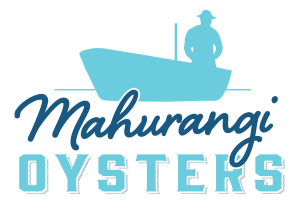In the quiet waters of the Mahurangi Harbour, a new kind of oyster farming is quietly growing. It is a method so innovative and effective that it promises not just better oysters, but a better world.
Flip farming is transforming the age-old practice of oyster farming. This new system, a marvel of engineering and ecology, is not only more sustainable and kinder to the environment, but it is also kinder to our hard-working oyster farmers.
Confirmed basket cases
At the heart of this flipping great system are baskets that float and move with the tides. These baskets are more than homes for our growing oysters; they are miniature gyms, where these marvellous molluscs develop strength and resilience.
The baskets stay afloat in an optimal zone. We can control where they hang, which makes a world of difference to the flavour of our oysters. The baskets rise and fall with the tide. This constant movement ensures that the oysters are always where food concentrations are higher so our oysters grow faster and more succulent.
But wait there’s more
The benefits of the flip farming system go even further than flipping delicious, higher-quality oysters for you to enjoy.
In traditional oyster farming, wooden sticks, often dipped in a slurry of sand and cement to create a rock-like texture, are placed in calmer waters where the spat settle and grow. The spat-catching bundles of sticks are kept wired up until the spat grow to a manageable size. After this, they are spread out on growing racks made of heavily treated timber. Thousands of collecting sticks are nailed to the racks with thin steel nails or staples which slowly rust away.
The racks are fixed to the seabed, and they can shade the area below. This can inhibit the area’s natural hydrodynamic processes. But not anymore.
The Flip Farm system replaces these rows of racks with strong lines, anchored at either end. We string the floating baskets upon these.
Because our baskets are suspended above the seabed and the floating lines continually shift due to wind and tide, any shading underneath the farm is greatly reduced.
And …. we can control the shape and size of our oysters while increasing the number of oysters grown in the same area as we would have using sticks. But because we lose fewer oysters, we double the production and that’s flipping great.
As oysters grow, so do the hangers-on
Biofouling organisms are things such as seaweed and barnacles. These aquatic nuisances can restrict water exchange and they can act as reservoirs for disease. Therefore, they require constant removal: a flipping tiring, labour-intensive slog.
We can now flip the baskets on a line. We can drive a barge to drive alongside the line with a specially designed attachment that lifts the baskets out of the water.
This periodic flipping of the baskets exposes all those problematic organisms to the sun, Therefore, they quickly desiccate and fall off. A huge flipping time-saver for us we’re very happy about that.
Another benefit: flipping the oyster baskets mimics the sea’s natural rhythms. The oysters spend short periods out of the water, exposed to the air. This brief exposure helps them build the muscle they need to hold their shells together. This means they remain fresh and intact longer after they leave the water, good for shelf life after harvest. Flipping also allows oysters to ‘harden off’, a crucial step in the oyster farming process.
Floating baskets have a smaller environmental impact
Flip Farming reduce the carbon footprint of our oyster cultivation even further. We can clean, maintain, retrieve, sort, and inspect our oysters with minimal disturbance to the surrounding environment. This benefits both our team and the beautiful harbour we operate in, which is flipping wonderful.
At Mahurangi Oysters, we are forever looking at our operational impacts and how we can help contribute to cleaner waters, healthier habitats, and more efficient farming operations. By moving our oyster farm to a floating system, we further our commitment to preserving our oceans and their vital ecosystems.

The benefits of flip farming are clear
Cleaner, higher quality oysters with a flipping great flavour, grown in a way that is better for the environment and more efficient for our farmers. The Flip farming system we use at Mahurangi Oysters is a movement towards a more sustainable and delicious future. And we’re flipping delighted!
The oyster of choice
Thanks to our careful husbandry and intelligent market selection, our plump Pacific oysters have become the oyster of choice in the Auckland restaurant scene and are exported in large numbers to Pacific Rim countries.
Feel free to contact us directly should you want more information. As a family business, we are very proud of what we produce and sell – and we only sell the best.

